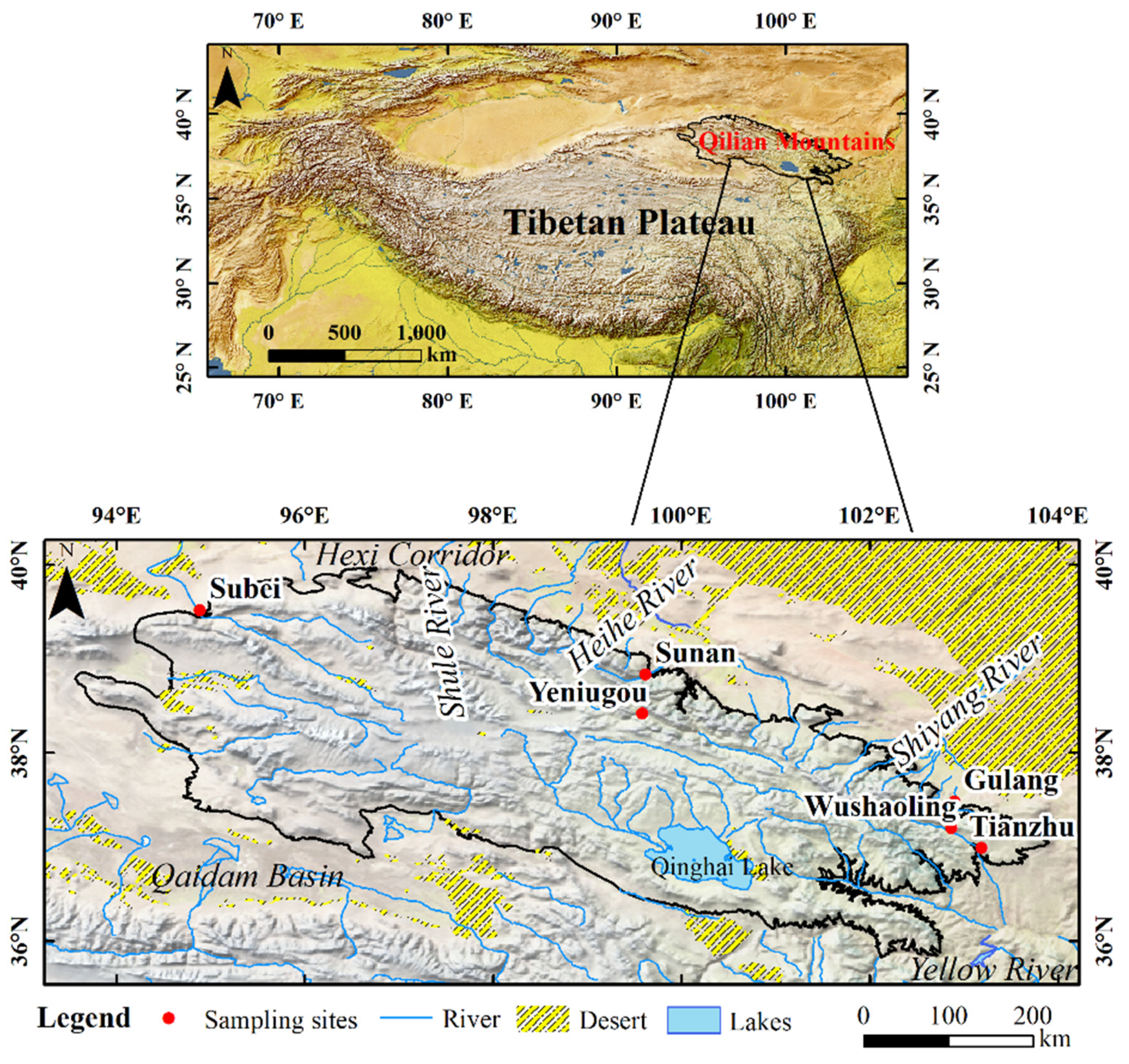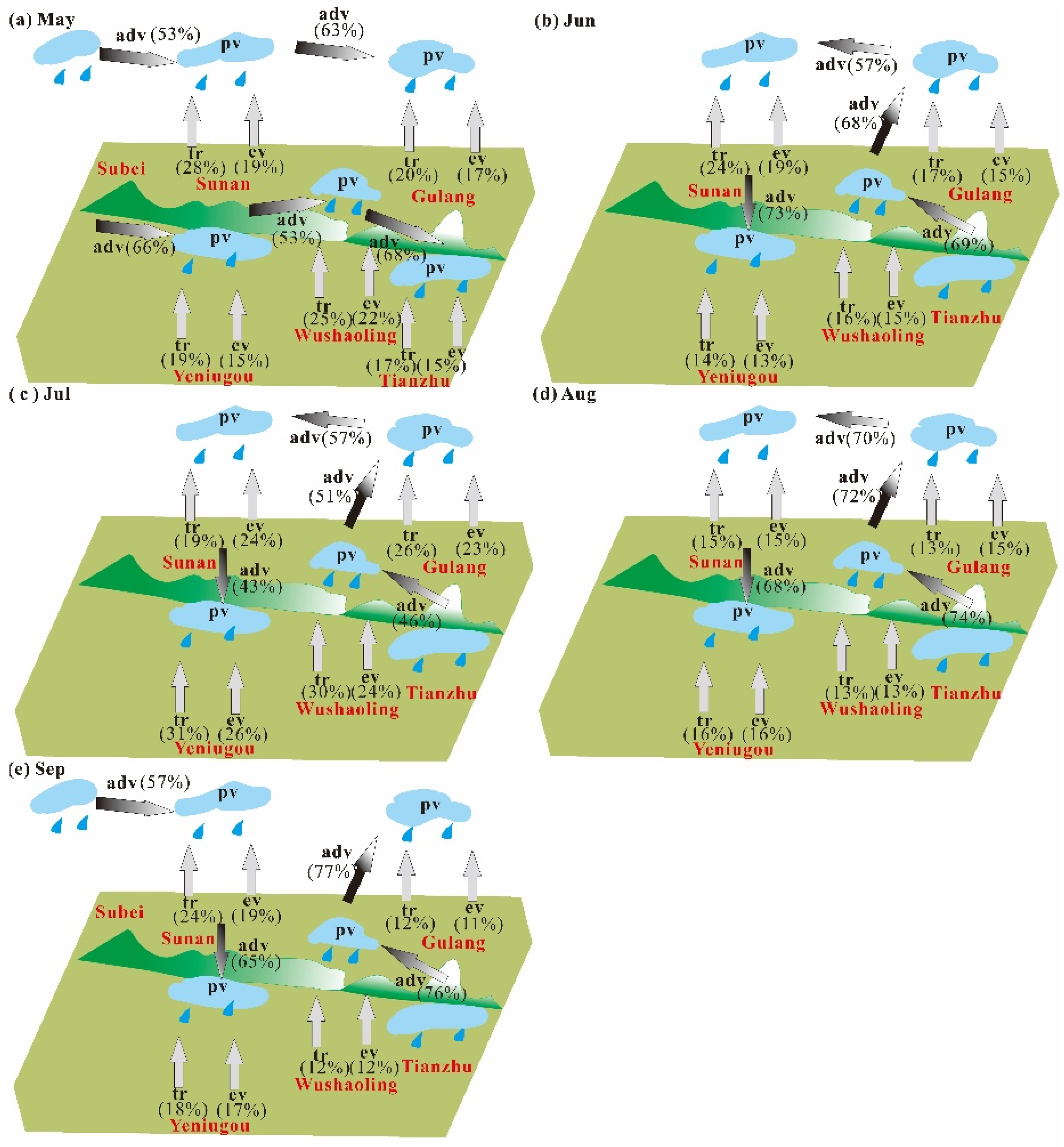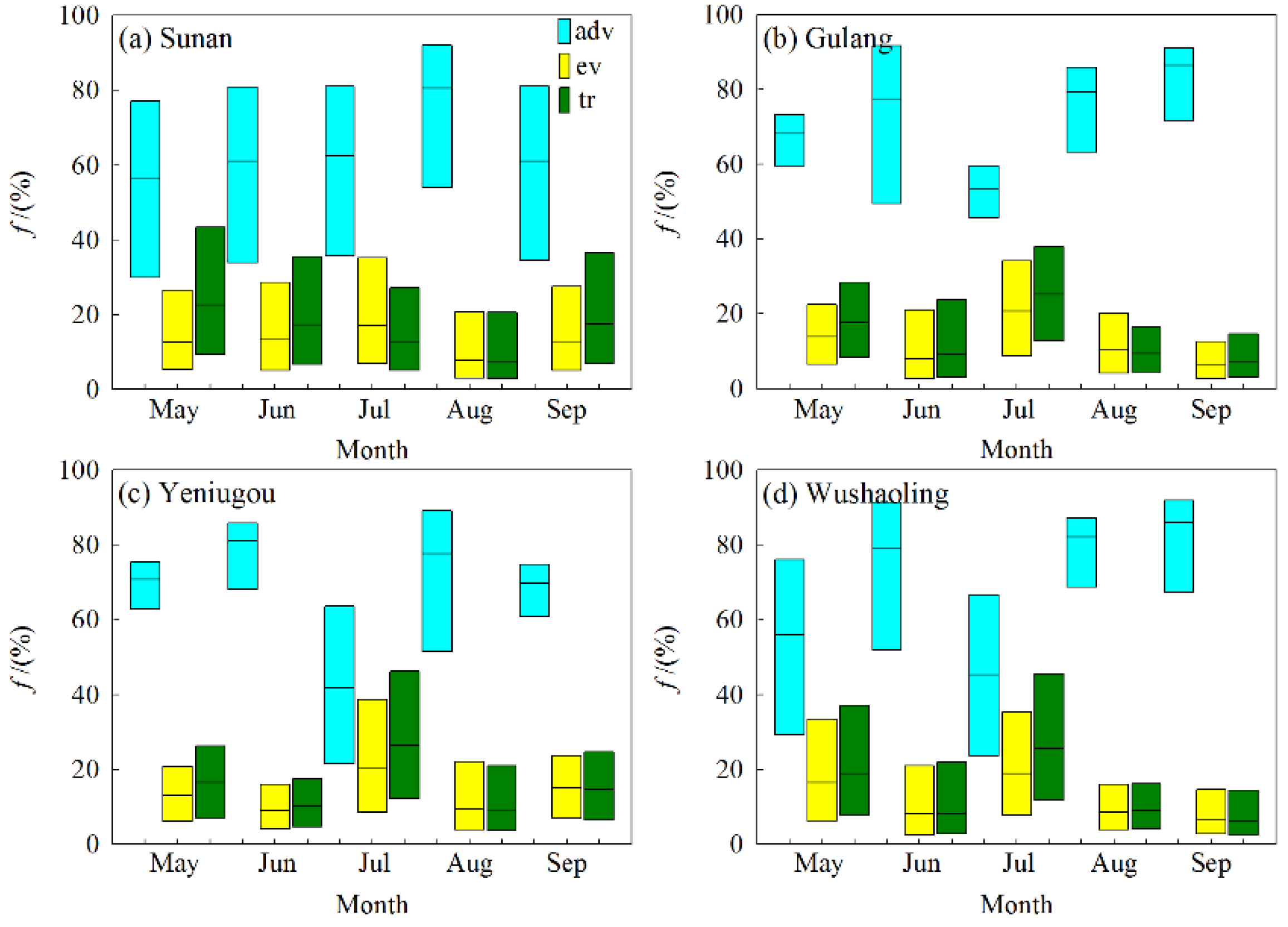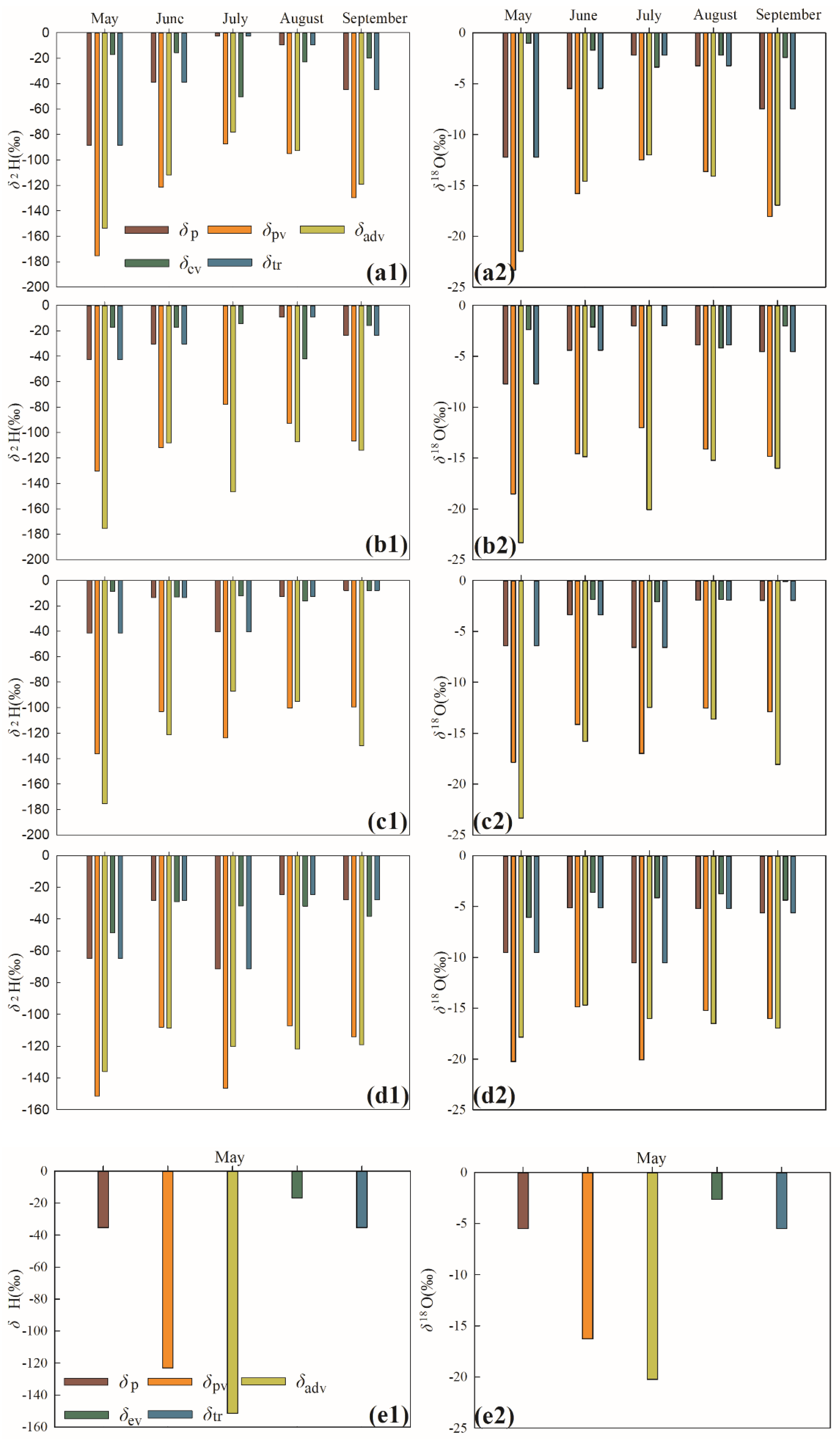Contribution of Recycled Moisture to Precipitation in Northeastern Tibetan Plateau: A Case Study Based on Bayesian Estimation
Abstract
:1. Introduction
2. Materials and Methods
2.1. Study Area
2.2. Sample Collection
2.3. Meteorological Data
2.4. Laboratory Analysis
2.5. Linear Mixing Model and Bayesian Mixing Model
2.6. Calculations
2.6.1. Isotope Composition in Precipitation Vapor (δpv)
2.6.2. Isotope Composition in Advected Vapor (δadv)
2.6.3. Isotope Composition in Transpirated Vapor (δtr)
2.6.4. Isotope Composition in Surface Evaporated Vapor (δev)
3. Results
3.1. Percent Contributions of Different Water Vapor to Local Precipitation
3.2. Isotopic Characteristics of Precipitation and Each Water Vapor
4. Discussion
5. Conclusions
Supplementary Materials
Author Contributions
Funding
Institutional Review Board Statement
Informed Consent Statement
Data Availability Statement
Acknowledgments
Conflicts of Interest
References
- Brubaker, K.L.; Entekhabi, D.; Eagleson, P.S. Estimation of continental precipitation recycling. J. Clim. 1993, 6, 1077–1089. [Google Scholar] [CrossRef] [Green Version]
- Eltahir, E.A.B.; Bras, R.L. Precipitation recycling. Rev. Geophys. 1996, 34, 367–378. [Google Scholar] [CrossRef]
- Trenberth, K.E. Atmospheric moisture recycling: Role of advection and local evaporation. J. Clim. 1999, 12, 1368–1381. [Google Scholar] [CrossRef]
- Salati, E.; Dall’Olio, A.; Matsui, E.; Gat, J.R. Recycling of water in the Amazon Basin: An isotopic study. Water Resour. Res. 1979, 15, 1250–1258. [Google Scholar] [CrossRef]
- Peng, T.R.; Liu, K.K.; Wang, C.H.; Chuang, K.H. A water isotope approach to assessing moisture recycling in the island-based precipitation of Taiwan: A case study in the western Pacific. Water Resour. Res. 2011, 47. [Google Scholar] [CrossRef]
- Kong, Y.; Pang, Z.; Froehlich, K. Quantifying recycled moisture fraction in precipitation of an arid region using deuterium excess. Tellus B 2013, 65, 19251. [Google Scholar] [CrossRef]
- Savenije, H.H. The runoff coefficient as the key to moisture recycling. J. Hydrol. 1996, 176, 219–225. [Google Scholar] [CrossRef]
- Holzman, B. Sources of moisture for precipitation in the United States. Tech. Bull. 1937, 589, 41. [Google Scholar]
- Benton, G.S.; Blackburn, R.T.; Snead, V.O. The role of the atmosphere in the hydrologic Cycle. Trans. Am. Geophys. Union 1950, 31, 61–73. [Google Scholar] [CrossRef]
- Benton, G.S.; Estoque, M.A. Water vapor transfer over the North American Continent. J. Meteorol. 1954, 11, 462–477. [Google Scholar] [CrossRef] [Green Version]
- Starr, V.P.; Peixoto, J.P. On the Global Balance of Water Vapor and the Hydrology of Deserts. Tellus 1958, 10, 188–194. [Google Scholar] [CrossRef] [Green Version]
- Zangvil, A.; Portis, D.H.; Lamb, P.J. Diurnal variations in the water vapor budget components over the Midwestern United States in summer 1979. In Interactions between Global Climate Subsystems; McBean, G.A., Hantel, M., Eds.; Geophysical Monograph: Whshington, DC, USA, 1993; pp. 53–63. [Google Scholar]
- Portis, D.H.; Zangvil, A.; Lamb, P.J. Variations of growing season water vapor and rainfall over Central North America. In Proceedings of the 15th Annual Climate Diagnostics Workshop, Washington, DC, USA, 10 May 2019; pp. 402–411. [Google Scholar]
- Stidd, C.K. Local Moisture and Precipitation, Preprint No. 45A (Revised July 1968); Desert Research Institute, University of Nevada: Reno, NV, USA, 1967; p. 34. [Google Scholar]
- Schickedanz, P.T. The Effect of Irrigation on Precipitation in the Great Plains (Rep. NSFGI-43871); University of Illinois: Urbana, IL, USA, 1976; p. 105. [Google Scholar]
- Dettwiller, J.; Changnon, S.A., Jr. Possible urban effects on maximum daily rainfall at Paris, St. Louis, and Chicago. J. Appl. Meteorol. 1976, 15, 517–519. [Google Scholar] [CrossRef] [Green Version]
- Anthes, R.A. Enhancement of Convective Precipitation by Mesoscale Variations in Vegetative Covering in Semiarid Regions. J. Clim. Appl. Meteorol. 1984, 23, 541–554. [Google Scholar] [CrossRef] [Green Version]
- Lettau, H.; Lettau, K.; Molion, L.C.B. Amazonia’s hydrologic cycle and the role of atmospheric recycling in assessing deforestation effects. Mon. Weather. Rev. 1979, 107, 227–238. [Google Scholar] [CrossRef] [Green Version]
- Savenije, H.H. New definitions for moisture recycling and the relationship with land-use changes in the Sahel. J. Hydrol. 1995, 167, 57–78. [Google Scholar] [CrossRef]
- Marlatt, W.E.; Budyko, M.I.; Miller, D.H. Climate and Life; Academic Press: New York, NY, USA, 1974. [Google Scholar]
- Eltahir, E.A.B.; Bras, R.L. Precipitation recycling in the Amazon basin. Q. J. R. Meteorol. Soc. 1994, 120, 861–880. [Google Scholar] [CrossRef]
- Zangvil, A.; Portis, D.H.; Lamb, P.J. Investigation of the Large-Scale Atmospheric Moisture Field over the Midwestern United States in Relation to Summer Precipitation. Part II: Recycling of Local Evapotranspiration and Association with Soil Moisture and Crop Yields. J. Clim. 2004, 17, 3283–3301. [Google Scholar] [CrossRef]
- Dominguez, F.; Kumar, P.; Liang, X.-Z.; Ting, M. Impact of Atmospheric Moisture Storage on Precipitation Recycling. J. Clim. 2006, 19, 1513–1530. [Google Scholar] [CrossRef]
- Shukla, J.; Mintz, Y. Influence of Land-Surface Evapotranspiration on the Earth’s Climate. Science 1982, 215, 1498–1501. [Google Scholar] [CrossRef]
- Joussaume, S.; Sadourny, R.; Jouzel, J. A general circulation model of water isotope cycles in the atmosphere. Nat. Cell Biol. 1984, 311, 24–29. [Google Scholar] [CrossRef]
- Koster, R.; Jouzel, J.; Suozzo, R.; Russell, G.; Broecker, W.; Rind, D.; Eagleson, P. Global sources of local precipitation as determined by the Nasa/Giss GCM. Geophys. Res. Lett. 1986, 13, 121–124. [Google Scholar] [CrossRef]
- Numaguti, A. Origin and recycling processes of precipitating water over the Eurasian continent: Experiments using an atmospheric general circulation model. J. Geophys. Res. Space Phys. 1999, 104, 1957–1972. [Google Scholar] [CrossRef]
- Bosilovich, M.G.; Sud, Y.; Schubert, S.D.; Walker, G.K. GEWEX CSE sources of precipitation using GCM water vapor tracers. In GEWEX News; International GEWEX Project Office: Silver Spring, MD, USA, 2002. [Google Scholar]
- Yoshimura, K.; Oki, T.; Ohte, N.; Kanae, S. Colored Moisture Analysis Estimates of Variations in 1998 Asian Monsoon Water Sources. J. Meteorol. Soc. Jpn. 2004, 82, 1315–1329. [Google Scholar] [CrossRef] [Green Version]
- Van Der Ent, R.J.; Savenije, H.H.G.; Schaefli, B.; Steele-Dunne, S.C. Origin and fate of atmospheric moisture over continents. Water Resour. Res. 2010, 46, W09525. [Google Scholar] [CrossRef] [Green Version]
- Keys, P.W.; Barnes, E.A.; Van Der Ent, R.J.; Gordon, L.J. Variability of moisture recycling using a precipitationshed framework. Hydrol. Earth Syst. Sci. 2014, 18, 3937–3950. [Google Scholar] [CrossRef] [Green Version]
- Zemp, D.C.; Schleussner, C.; Barbosa, H.M.J.; Van Der Ent, R.J.; Donges, J.F.; Heinke, J.; Sampaio, G.; Rammig, A. On the importance of cascading moisture recycling in South America. Atmos. Chem. Phys. Discuss. 2014, 14, 13337–13359. [Google Scholar] [CrossRef] [Green Version]
- Hua, L.; Zhong, L.; Ke, Z. Characteristics of the precipitation recycling ratio and its relationship with regional precipitation in China. Theor. Appl. Clim. 2015, 127, 513–531. [Google Scholar] [CrossRef]
- Clark, I.D.; Fritz, P. Environmental Isotopes in Hydrogeology; CRC Press: Boca Raton, FL, USA, 2013. [Google Scholar]
- Genereux, D. Quantifying uncertainty in tracer-based hydrograph separations. Water Resour. Res. 1998, 34, 915–919. [Google Scholar] [CrossRef]
- Peng, H.; Mayer, B.; Norman, A.-L.; Krouse, H.R. Modelling of hydrogen and oxygen isotope compositions for local precipitation. Tellus B 2005, 57, 273–282. [Google Scholar] [CrossRef]
- Froehlich, K.; Kralik, M.; Papesch, W.; Rank, D.; Scheifinger, H.; Stichler, W. Deuterium excess in precipitation of Alpine regions—moisture recycling. Isot. Environ. Health Stud. 2008, 44, 61–70. [Google Scholar] [CrossRef]
- Zongxing, L.; Qi, F.; Wang, Q.J.; Yanlong, K.; Aifang, C.; Song, Y.; Yongge, L.; Jianguo, L.; Xiaoyan, G. Contributions of local terrestrial evaporation and transpiration to precipitation using δ 18 O and D-excess as a proxy in Shiyang inland river basin in China. Glob. Planet. Chang. 2016, 146, 140–151. [Google Scholar] [CrossRef]
- Wang, S.; Zhang, M.; Che, Y.; Chen, F.; Qiang, F. Contribution of recycled moisture to precipitation in oases of arid central Asia: A stable isotope approach. Water Resour. Res. 2016, 52, 3246–3257. [Google Scholar] [CrossRef] [Green Version]
- Phillips, D.L.; Gregg, J.W. Uncertainty in source partitioning using stable isotopes. Oecologia 2001, 127, 171–179. [Google Scholar] [CrossRef] [PubMed]
- Moore, J.W.; Semmens, B.X. Incorporating uncertainty and prior information into stable isotope mixing models. Ecol. Lett. 2008, 11, 470–480. [Google Scholar] [CrossRef] [PubMed]
- Ward, E.J.; Semmens, B.X.; Schindler, D.E. Including Source Uncertainty and Prior Information in the Analysis of Stable Isotope Mixing Models. Environ. Sci. Technol. 2010, 44, 4645–4650. [Google Scholar] [CrossRef]
- Semmens, B.X.; Ward, E.J.; Moore, J.W.; Darimont, C.T. Quantifying Inter- and Intra-Population Niche Variability Using Hierarchical Bayesian Stable Isotope Mixing Models. PLoS ONE 2009, 4, e6187. [Google Scholar] [CrossRef]
- Francis, T.B.; Schindler, D.E.; Holtgrieve, G.W.; Larson, E.R.; Scheuerell, M.D.; Semmens, B.X.; Ward, E.J. Habitat structure determines resource use by zooplankton in temperate lakes. Ecol. Lett. 2011, 14, 364–372. [Google Scholar] [CrossRef]
- Parnell, A.C.; Phillips, D.L.; Bearhop, S.; Semmens, B.X.; Ward, E.J.; Moore, J.W.; Jackson, A.L.; Grey, J.; Kelly, D.J.; Inger, R. Bayesian stable isotope mixing models. Environmetrics 2013, 24, 387–399. [Google Scholar] [CrossRef] [Green Version]
- Stock, B.C.; Semmens, B.X. MixSARI GUI User Manual, Version 3.1. 2013. Available online: https://github.com/brianstock/MixSIAR/ (accessed on 30 December 2017).
- Ma, Z.; Kang, S.; Zhang, L.; Tong, L.; Su, X. Analysis of impacts of climate variability and human activity on streamflow for a river basin in arid region of northwest China. J. Hydrol. 2008, 352, 239–249. [Google Scholar] [CrossRef]
- Wang, P.; Li, Z.; Gao, W. Rapid shrinking of glaciers in the Middle Qilian Mountain region of Northwest China during the last ∼50 years. J. Earth Sci. 2011, 22, 539–548. [Google Scholar] [CrossRef]
- Li, Z.; Gui, J.; Wang, X.; Feng, Q.; Zhao, T.; Ouyang, C.; Guo, X.; Zhang, B.; Shi, Y. Water resources in inland regions of central Asia: Evidence from stable isotope tracing. J. Hydrol. 2019, 570, 1–16. [Google Scholar] [CrossRef]
- Zhu, G.; Guo, H.; Qin, D.; Pan, H.; Zhang, Y.; Jia, W.; Ma, X. Contribution of recycled moisture to precipitation in the monsoon marginal zone: Estimate based on stable isotope data. J. Hydrol. 2019, 569, 423–435. [Google Scholar] [CrossRef]
- Qiu, X.; Zhang, M.; Wang, S.; Evaristo, J.; Argiriou, A.A.; Guo, R.; Chen, R.; Meng, H.; Che, C.; Qu, D. The test of the ecohydrological separation hypothesis in a dry zone of the northeastern Tibetan Plateau. Ecohydrol. 2019, 12, e2077. [Google Scholar] [CrossRef]
- Mook, W.G. Environmental Isotopes in the Hydrological Cycle: Principles and Applications; International Atomic Energy Agency: Vienna, Austria, 2000. [Google Scholar]
- R Core Team. R: A Language and Environment for Statistical Computing; R Foundation for Statistical Computing: Vienna, Austria, 2020; Available online: http://www.R-project.org/ (accessed on 11 March 2021).
- Plummer, M. JAGS: A program for analysis of Bayesian graphical models using Gibbs sampling. In Proceedings of the 3rd International Workshop on Distributed Statistical Computing, Lyon, France, 20–23 March 2003; pp. 1–8. [Google Scholar]
- Stock, B.C.; Jackson, A.L.; Ward, E.J.; Parnell, A.C.; Phillips, D.L.; Semmens, B.X. Analyzing mixing systems using a new generation of Bayesian tracer mixing models. PeerJ 2018, 6, e5096. [Google Scholar] [CrossRef] [PubMed]
- Skrzypek, G.; Mydłowski, A.; Dogramaci, S.; Hedley, P.; Gibson, J.J.; Grierson, P.F. Estimation of evaporative loss based on the stable isotope composition of water using Hydrocalculator. J. Hydrol. 2015, 523, 781–789. [Google Scholar] [CrossRef] [Green Version]
- Gibson, J.; Reid, R. Water balance along a chain of tundra lakes: A 20-year isotopic perspective. J. Hydrol. 2014, 519, 2148–2164. [Google Scholar] [CrossRef]
- E Bennett, K.; Gibson, J.J.; McEachern, P.M. Water-yield estimates for critical loadings assessment: Comparisons of gauging methods versus an isotopic approach. Can. J. Fish. Aquat. Sci. 2008, 65, 83–99. [Google Scholar] [CrossRef]
- Horita, J.; Wesolowski, D.J. Liquid-vapor fractionation of oxygen and hydrogen isotopes of water from the freezing to the critical temperature. Geochim. Cosmochim. Acta 1994, 58, 3425–3437. [Google Scholar] [CrossRef]
- Gibson, J.; Reid, R. Stable isotope fingerprint of open-water evaporation losses and effective drainage area fluctuations in a subarctic shield watershed. J. Hydrol. 2010, 381, 142–150. [Google Scholar] [CrossRef]
- Gat, J.R. Stable isotopes of fresh and saline lakes. In Physics and Chemistry of Lakes; Lerman, A., Imboden, D.M., Gat, J.R., Eds.; Springer: New York, NY, USA, 1995; pp. 139–165. [Google Scholar]
- Gonfiantini, R. Environmental isotopes in lake studies. In Handbook of Environmental Isotope Geochemistry, 2: Terrestrial Environment; Fritz, P., Fontes, J.C., Eds.; Elsevier: Amsterdam, The Netherlands, 1986; pp. 113–168. [Google Scholar]
- Araguás, A.L.; Froehlich, K.; Rozanski, K. Deuterium and oxygen-18 isotope composition of precipitation and atmospheric moisture. Hydrol. Process. 2000, 14, 1341–1355. [Google Scholar] [CrossRef]
- Gonfiantini, R.; Gratziu, S.; Tongiorgi, E. Oxygen Isotopic Composition of Water in Leaves. In Isotopes and Radiation in Soil-Plant Nutrition Studies; International Atomic Energy Agency: Vienna, Austria, 1965; p. 410. [Google Scholar]
- Wershaw, R.; Friedman, I.; Heller, S.; Frank, P. Hydrogen isotope fractionation of water passing through trees. In Advances in Organic Geochemistry; Hobson, F., Speers, M., Eds.; Pergamon Press: Bergama, Turkey, 1966; pp. 55–67. [Google Scholar]
- White, J.W.; Cook, E.R.; Lawrence, J.R.; Broecker, W.S. The ratios of sap in trees: Implications for water sources and tree ring ratios. Geochim. Cosmochim. Acta 1985, 49, 237–246. [Google Scholar] [CrossRef]
- Craig, H.; Gordon, L.I. Deuterium and oxygen 18 variations in the ocean and the marine atmosphere. In Proceedings of the Stable Isotopes in Oceanographic Studies and Paleotemperatures; Geologic Nuclear Laboratory: Spoleto, Italy, 1965; pp. 9–130. [Google Scholar]
- Gat, J.R.; Bowser, C.J.; Kendall, C. The contribution of evaporation from the Great Lakes to the continental atmosphere: Estimate based on stable isotope data. Geophys. Res. Lett. 1994, 21, 557–560. [Google Scholar] [CrossRef]
- Gat, J.R. Oxygen and hydrogen isotopes in the hydrologic cycle. Annu. Rev. Earth Planet. Sci. 1996, 24, 225–262. [Google Scholar] [CrossRef] [Green Version]
- Merlivat, L. The dependence of bulk evaporation coefficients on air-water interfacial conditions as determined by the isotopic method. J. Geophys. Res. Space Phys. 1978, 83, 2977–2980. [Google Scholar] [CrossRef]
- Lee, X.; Sargent, S.; Smith, R.; Tanner, B. In Situ Measurement of the Water Vapor 18O/16O Isotope Ratio for Atmospheric and Ecological Applications. J. Atmos. Ocean. Technol. 2005, 22, 555–565. [Google Scholar] [CrossRef]
- Wen, X.F.; Zhang, S.C.; Sun, X.M.; Yu, G.R.; Lee, X. Water vapor and precipitation isotope ratios in Beijing, China. J. Geophys. Res. Space Phys. 2010, 115, D01103. [Google Scholar] [CrossRef] [Green Version]
- Liu, J.; Xiao, C.; Ding, M.; Ren, J. Variations in stable hydrogen and oxygen isotopes in atmospheric water vapor in the marine boundary layer across a wide latitude range. J. Environ. Sci. 2014, 26, 2266–2276. [Google Scholar] [CrossRef]
- Zongxing, L.; Yan, G.; Yamin, W.; Yanhui, P.; Jianguo, L.; Aifang, C.; Tingting, W.; Chuntan, H.; Yaoxuan, S.; Theakstone, W. Can monsoon moisture arrive in the Qilian Mountains in summer? Quat. Int. 2015, 358, 113–125. [Google Scholar] [CrossRef]
- Wu, Y.; Zhou, H.; Zheng, X.J.; Li, Y.; Tang, L.S. Seasonal changes in the water use strategies of three cooccurring desert shrubs. Hydrol. Process. 2014, 28, 6265–6275. [Google Scholar] [CrossRef]
- Dai, Y.; Zheng, X.J.; Tang, L.S.; Li, Y. Stable oxygen isotopes reveal distinct water use patterns of two Haloxylon species in the Gurbantonggut Desert. Plant Soil 2015, 389, 73–87. [Google Scholar] [CrossRef]
- Zhou, H.; Zhao, W.; Zheng, X.; Li, S. Root distribution of Nitraria sibirica with seasonally varying water sources in a desert habitat. J. Plant Res. 2015, 128, 613–622. [Google Scholar] [CrossRef] [PubMed]
- Wang, L.; Good, S.P.; Caylor, K.K.; Cernusak, L.A. Direct quantification of leaf transpiration isotopic composition. Agric. For. Meteorol. 2012, 154–155, 127–135. [Google Scholar] [CrossRef]
- Dubbert, M.; Cuntz, M.; Piayda, A.; Werner, C. Oxygen isotope signatures of transpired water vapor: The role of isotopic non-steady-state transpiration under natural conditions. New Phytol. 2014, 203, 1242–1252. [Google Scholar] [CrossRef] [PubMed]




| Study Area | Percent Contributions | Reference | |
|---|---|---|---|
| Recycled Moisture | Advected Vapor | ||
| Taiwan Island | 37% | 63% | Peng et al. (2011) [5] |
| Urumqi river basin | less than 2.0 ± 0.6% | / | Kong et al. (2013) [6] |
| Shiyang river basin | 9% for evaporation and 14% for transpiration | 77% | Li et al. (2016) [38] |
| Tianshan Mountains | 16.2% at large oases of Urumqi; less than 5% at small oases such as Caijiahu and Shihezi | / | Wang et al. (2016) [39] |
| Northwestern China | 10–14% | / | Hua et al. (2017) [46] |
| Shiyang river basin | 17% in the mountain regions, 28% in the oasis regions, 15% in the desert regions | 83% in the mountain regions, 72% in the oasis regions, 85% in the desert regions | Zhu et al. (2019) [50] |
| Station | Latitude | Longitude | Elevation (m) | T (°C) | P (mm) | h (%) |
|---|---|---|---|---|---|---|
| Subei | 39°31′ | 94°52′ | 2137 | 7.3 | 124 | 41 |
| Sunan | 38°50′ | 99°37′ | 2311 | 5.1 | 216 | 49 |
| Gulang | 37°29′ | 102°54′ | 2072 | 7.3 | 232 | 46 |
| Yeniugou | 38°25′ | 99°35′ | 3320 | −1.7 | 512 | 60 |
| Tianzhu | 36°59′ | 103°11′ | 2484 | 4.1 | 236 | 58 |
| Wushaoling | 37°12′ | 102°52′ | 3045 | 1.3 | 494 | 60 |
| Sites | Precipitation | Soil | Pan Experiment |
|---|---|---|---|
| Subei | 42 | 55 | 30 |
| Sunan | 44 | 55 | 31 |
| Gulang | 19 | 55 | 29 |
| Yeniugou | 60 | 55 | 30 |
| Tianzhu | 35 | 55 | 20 |
| Wusaholing | 50 | 55 | 30 |
| Sites | Month | fadv/% | fev/% | ftr/% |
|---|---|---|---|---|
| Sunan | May | 53 | 19 | 28 |
| June | 57 | 19 | 24 | |
| July | 57 | 24 | 19 | |
| August | 70 | 15 | 15 | |
| September | 57 | 19 | 24 | |
| Gulang | May | 63 | 17 | 20 |
| June | 68 | 15 | 17 | |
| July | 51 | 23 | 26 | |
| August | 72 | 15 | 13 | |
| September | 77 | 11 | 12 | |
| Yeniugou | May | 66 | 15 | 19 |
| June | 73 | 13 | 14 | |
| July | 43 | 26 | 31 | |
| August | 68 | 16 | 16 | |
| September | 65 | 17 | 18 | |
| Wushaoling | May | 53 | 22 | 25 |
| June | 69 | 15 | 16 | |
| July | 46 | 24 | 30 | |
| August | 74 | 13 | 13 | |
| September | 76 | 12 | 12 | |
| Tianzhu | May | 68 | 15 | 17 |
| Sites | Months | Three-End-Member | Two-End-Member | ||||
|---|---|---|---|---|---|---|---|
| fadv/% | fev/% | ftr/% | fadv/% | fev/% | ftr/% | ||
| Sunan | 5 | 240 | 99 | −239 | 109 | −9 | / |
| 6 | 112 | −2 | −10 | 109 | −9 | / | |
| 7 | 103 | 14 | −17 | 105 | 5 | / | |
| 8 | 98 | 28 | −26 | 96 | 4 | / | |
| 9 | 119 | 13 | −32 | 108 | −8 | / | |
| Gulang | 5 | 62 | −21 | 59 | 69 | / | 31 |
| 6 | 128 | 142 | −170 | 98 | 2 | / | |
| 7 | 55 | −3 | 48 | 55 | / | 45 | |
| 8 | 90 | −15 | 25 | 90 | / | 10 | |
| 9 | 93 | 16 | −9 | 92 | 8 | / | |
| Yeniugou | 5 | 76 | 23 | 1 | 76 | 23 | 1 |
| 6 | 83 | −31 | 48 | 87 | / | 13 | |
| 7 | 183 | 9 | −92 | 143 | −43 | / | |
| 8 | 93 | 334 | −327 | 91 | 9 | / | |
| 9 | 75 | 63 | −38 | 71 | 29 | / | |
| Wushaoling | 5 | 113 | −39 | 26 | 129 | / | −29 |
| 6 | 100 | −13 | 13 | 102 | / | −2 | |
| 7 | 109 | −56 | 47 | 174 | / | 74 | |
| 8 | 86 | −18 | 32 | 89 | / | 11 | |
| 9 | 93 | 13 | −6 | 92 | 8 | / | |
| Tianzhu | 5 | 87 | 75 | −62 | 77 | 23 | / |
Publisher’s Note: MDPI stays neutral with regard to jurisdictional claims in published maps and institutional affiliations. |
© 2021 by the authors. Licensee MDPI, Basel, Switzerland. This article is an open access article distributed under the terms and conditions of the Creative Commons Attribution (CC BY) license (https://creativecommons.org/licenses/by/4.0/).
Share and Cite
Qiu, X.; Zhang, M.; Dong, Z.; Wang, S.; Yu, X.; Meng, H.; Che, C. Contribution of Recycled Moisture to Precipitation in Northeastern Tibetan Plateau: A Case Study Based on Bayesian Estimation. Atmosphere 2021, 12, 731. https://doi.org/10.3390/atmos12060731
Qiu X, Zhang M, Dong Z, Wang S, Yu X, Meng H, Che C. Contribution of Recycled Moisture to Precipitation in Northeastern Tibetan Plateau: A Case Study Based on Bayesian Estimation. Atmosphere. 2021; 12(6):731. https://doi.org/10.3390/atmos12060731
Chicago/Turabian StyleQiu, Xue, Mingjun Zhang, Zhiwen Dong, Shengjie Wang, Xiuxiu Yu, Hongfei Meng, and Cunwei Che. 2021. "Contribution of Recycled Moisture to Precipitation in Northeastern Tibetan Plateau: A Case Study Based on Bayesian Estimation" Atmosphere 12, no. 6: 731. https://doi.org/10.3390/atmos12060731






